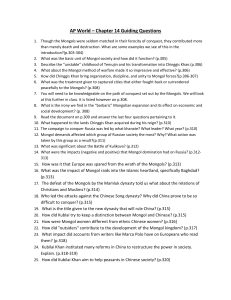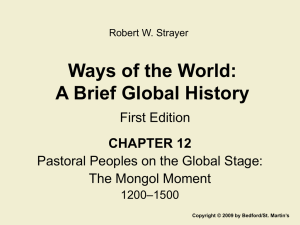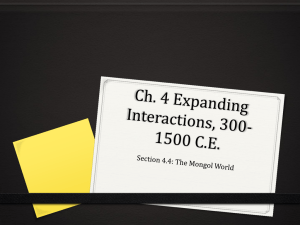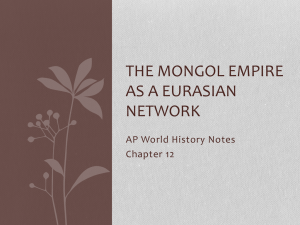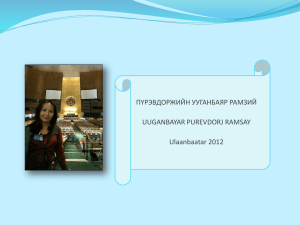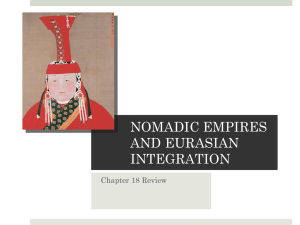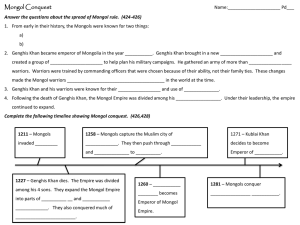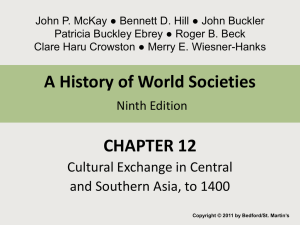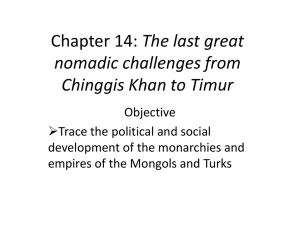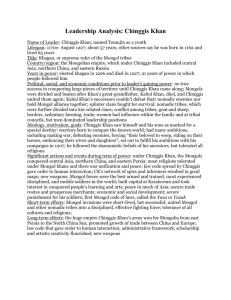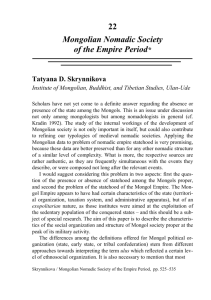The Mongol War Machine In the 13th century the Mongol army was
advertisement
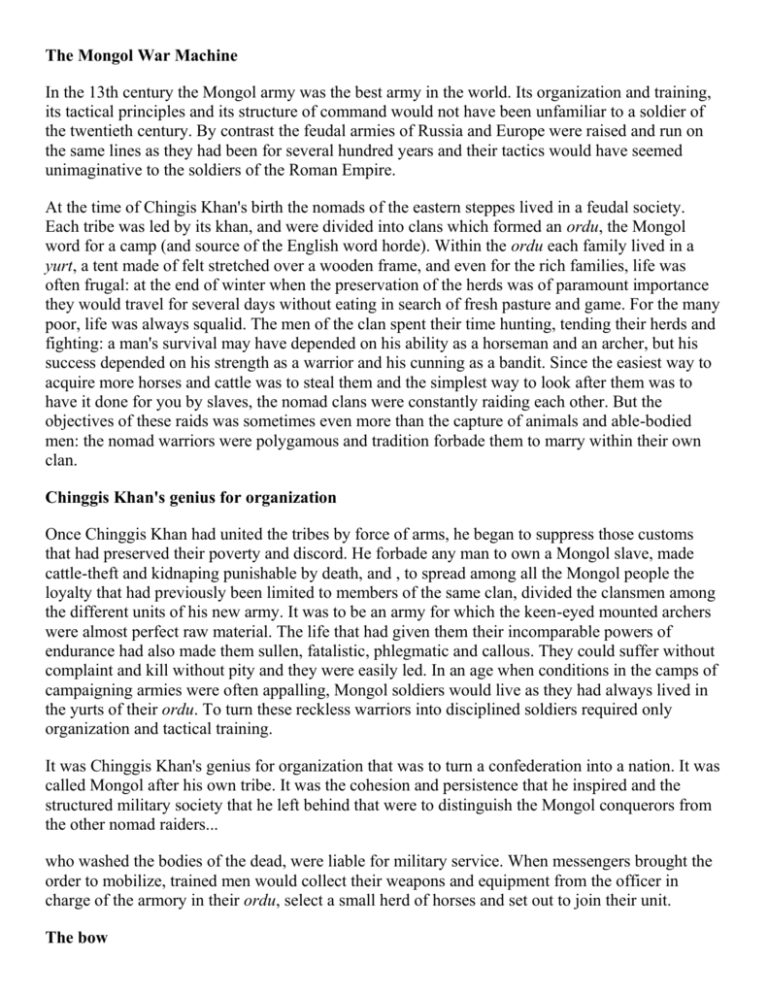
The Mongol War Machine In the 13th century the Mongol army was the best army in the world. Its organization and training, its tactical principles and its structure of command would not have been unfamiliar to a soldier of the twentieth century. By contrast the feudal armies of Russia and Europe were raised and run on the same lines as they had been for several hundred years and their tactics would have seemed unimaginative to the soldiers of the Roman Empire. At the time of Chingis Khan's birth the nomads of the eastern steppes lived in a feudal society. Each tribe was led by its khan, and were divided into clans which formed an ordu, the Mongol word for a camp (and source of the English word horde). Within the ordu each family lived in a yurt, a tent made of felt stretched over a wooden frame, and even for the rich families, life was often frugal: at the end of winter when the preservation of the herds was of paramount importance they would travel for several days without eating in search of fresh pasture and game. For the many poor, life was always squalid. The men of the clan spent their time hunting, tending their herds and fighting: a man's survival may have depended on his ability as a horseman and an archer, but his success depended on his strength as a warrior and his cunning as a bandit. Since the easiest way to acquire more horses and cattle was to steal them and the simplest way to look after them was to have it done for you by slaves, the nomad clans were constantly raiding each other. But the objectives of these raids was sometimes even more than the capture of animals and able-bodied men: the nomad warriors were polygamous and tradition forbade them to marry within their own clan. Chinggis Khan's genius for organization Once Chinggis Khan had united the tribes by force of arms, he began to suppress those customs that had preserved their poverty and discord. He forbade any man to own a Mongol slave, made cattle-theft and kidnaping punishable by death, and , to spread among all the Mongol people the loyalty that had previously been limited to members of the same clan, divided the clansmen among the different units of his new army. It was to be an army for which the keen-eyed mounted archers were almost perfect raw material. The life that had given them their incomparable powers of endurance had also made them sullen, fatalistic, phlegmatic and callous. They could suffer without complaint and kill without pity and they were easily led. In an age when conditions in the camps of campaigning armies were often appalling, Mongol soldiers would live as they had always lived in the yurts of their ordu. To turn these reckless warriors into disciplined soldiers required only organization and tactical training. It was Chinggis Khan's genius for organization that was to turn a confederation into a nation. It was called Mongol after his own tribe. It was the cohesion and persistence that he inspired and the structured military society that he left behind that were to distinguish the Mongol conquerors from the other nomad raiders... who washed the bodies of the dead, were liable for military service. When messengers brought the order to mobilize, trained men would collect their weapons and equipment from the officer in charge of the armory in their ordu, select a small herd of horses and set out to join their unit. The bow The bow was easily the Mongols' most important weapon. The mediaeval English longbow had a pull of 75 pounds and a range of up to 250 yards, but the smaller bows used by the Mongols had a pull of between 100-150 pounds and a range of over 350 yards. The velocity was further increased by the difficult technique known as the Mongolian thumb lock: the string was drawn back by a stone ring worn on the right thumb which released it more suddenly than the fingers. A soldier could bend and string his bow in the saddle by placing one end between his foot and the stirrup and he could shoot in any direction at full gallop, carefully timing his release to come between the paces of his horse, so that his aim would not be deflected as the hooves pounded the ground. Whenever possible Mongols preferred to ride mares, since their milk as well as their blood, and in the last resort their flesh, provided them with everything they needed to survive. The Mongol nomads valued their horses far above all other possessions. Horses played their part in traditional ceremonies and folklore and there was a whole period in Chinese art when all the statues and paintings were of horses, since the Mongol patrons desired nothing else. War horses were treated with the same sentimental respect as any other comrade in arms. A horse that had been ridden in battle was never killed for food and when it became old or lame it was put out to grass, although when a soldier died his favorite horse was killed and buried with him so that their spirits would ride together. To their enemies, the inexplicable coordination with which Mongol armies achieved their separate and common objectives was often astounding. Although their battlefield tactics were no more than the adaptation and perfection of those that had been developed by nomad archers over the past seven or eight hundred years, each carefully-designed campaign was a masterpiece of original and imaginative strategy and Mongol commanders could not have planned with as much breadth and daring as they did without absolute confidence in their communications. ...The Mongol army was a ‘modern' army and the differences between it and the armies of the twentieth century can all be accounted for by progress in science and in technology, but not in the art of war.
